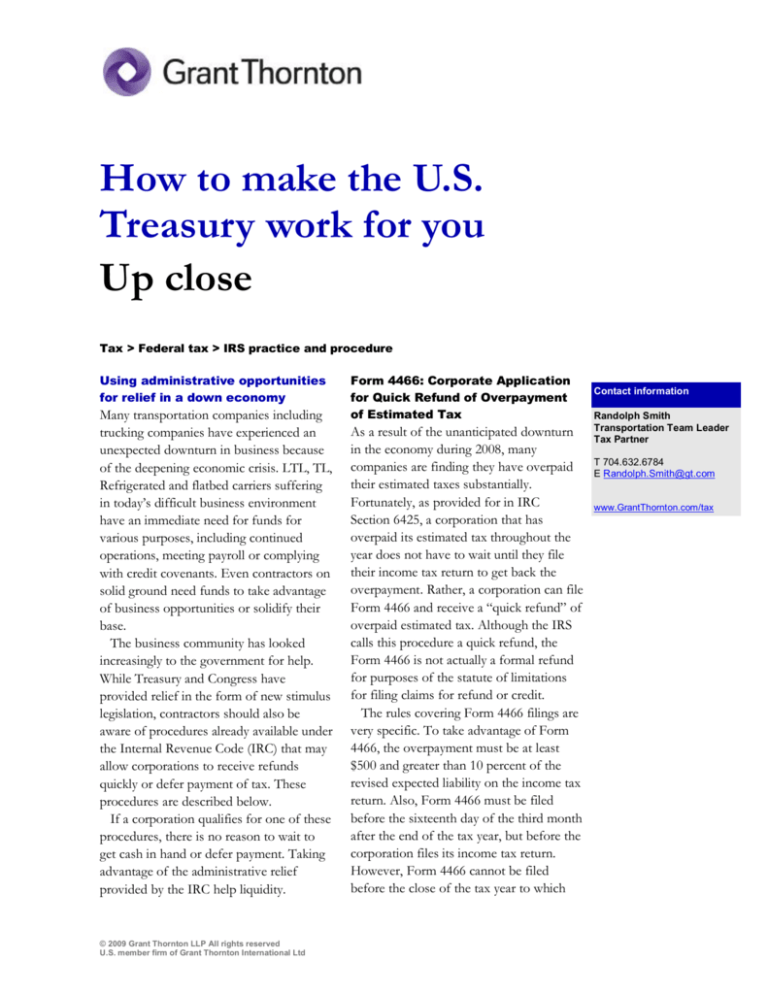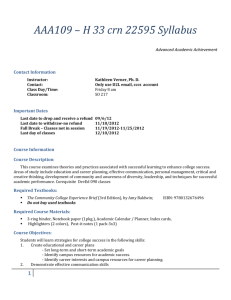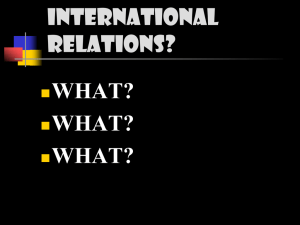
How to make the U.S.
Treasury work for you
Up close
Tax > Federal tax > IRS practice and procedure
Using administrative opportunities
for relief in a down economy
Many transportation companies including
trucking companies have experienced an
unexpected downturn in business because
of the deepening economic crisis. LTL, TL,
Refrigerated and flatbed carriers suffering
in today’s difficult business environment
have an immediate need for funds for
various purposes, including continued
operations, meeting payroll or complying
with credit covenants. Even contractors on
solid ground need funds to take advantage
of business opportunities or solidify their
base.
The business community has looked
increasingly to the government for help.
While Treasury and Congress have
provided relief in the form of new stimulus
legislation, contractors should also be
aware of procedures already available under
the Internal Revenue Code (IRC) that may
allow corporations to receive refunds
quickly or defer payment of tax. These
procedures are described below.
If a corporation qualifies for one of these
procedures, there is no reason to wait to
get cash in hand or defer payment. Taking
advantage of the administrative relief
provided by the IRC help liquidity.
© 2009 Grant Thornton LLP All rights reserved
U.S. member firm of Grant Thornton International Ltd
Form 4466: Corporate Application
for Quick Refund of Overpayment
of Estimated Tax
As a result of the unanticipated downturn
in the economy during 2008, many
companies are finding they have overpaid
their estimated taxes substantially.
Fortunately, as provided for in IRC
Section 6425, a corporation that has
overpaid its estimated tax throughout the
year does not have to wait until they file
their income tax return to get back the
overpayment. Rather, a corporation can file
Form 4466 and receive a “quick refund” of
overpaid estimated tax. Although the IRS
calls this procedure a quick refund, the
Form 4466 is not actually a formal refund
for purposes of the statute of limitations
for filing claims for refund or credit.
The rules covering Form 4466 filings are
very specific. To take advantage of Form
4466, the overpayment must be at least
$500 and greater than 10 percent of the
revised expected liability on the income tax
return. Also, Form 4466 must be filed
before the sixteenth day of the third month
after the end of the tax year, but before the
corporation files its income tax return.
However, Form 4466 cannot be filed
before the close of the tax year to which
Contact information
Randolph Smith
Transportation Team Leader
Tax Partner
T 704.632.6784
E Randolph.Smith@gt.com
www.GrantThornton.com/tax
the overpayment relates. An extension of
time to file the corporation’s income tax
return (i.e., Form 7004) will not extend the
time for filing Form 4466.
Unless there are errors or omissions on
Form 4466, the IRS must act on the
application within 45 days of filing. If the
IRS denies the application because of
errors or omissions, a taxpayer can still
request a refund on the original return or
on an amended return.
If granted, the IRS considers the quick
refund an adjustment to the estimated tax
payments on the day the quick refund is
made. Note: If a refund of the estimated
tax payment is excessive, there may be a
penalty assessment under IRC Section
6655 without any possibility of reasonable
cause relief. Taxpayers should also be
aware that if any outstanding tax liabilities
exist, the IRS will offset the amount to be
refunded against the liabilities.
Form 1139: Corporate Application
for a Tentative Refund
Corporations can file Form 1139 to receive
a quick tentative refund if they have net
operating losses (NOLs), net capital losses
or business credit carrybacks. The rules
governing Form 1139 can be found in IRC
Section 6411 and related regulations. Like
Form 4466, the advantage of Form 1139 is
that the taxpayer receives the “tentative”
refund before the IRS audits the return. In
contrast, a refund request on Form 1120X
may be subject to an IRS examination
before it is paid. Also, refund requests on
Form 1120X in excess of $2 million are
subject to review by the Joint Committee
on Taxation. No matter the amount,
Forms 1139 are not subject to pre-refund
review. However, amounts on Form 1139
in excess of $2 million will be subject to
post-refund review.
© 2009 Grant Thornton LLP All rights reserved
U.S. member firm of Grant Thornton International Ltd
Under IRC Section 6411, Form 1139 must
be filed within 12 months after the end of
the tax year in which the loss or unused
business credit was generated. However,
Form 1139 must not be filed before Form
1120 for the year of the loss or credit is
filed. Importantly, the IRS must act on
Form 1139 within 90 days of the later of
the filing of the form or from the last day
of the month that the return for the loss or
credit year is due (including extensions).
Once Form 1139 is received by the IRS,
a limited review is performed to determine
if there are any errors or omissions. Form
1139 can be rejected if the IRS determines
there are material omissions or errors that
cannot be corrected within 90 days. A
rejection cannot be challenged, so a
taxpayer’s only administrative recourse is
filing Form 1120X.
If there are no material errors or
omissions on Form 1139, the IRS generally
will pay a refund within 45 days to avoid
paying interest to the taxpayer. Before a
check is issued, the IRS will offset the
refund against any outstanding tax liability,
including unassessed liabilities shown in a
statutory notice of deficiency or in a proof
of claim filed in a bankruptcy proceeding.
However, the fact that a carryback year is
under examination will not prevent the IRS
from issuing a tentative refund.
Remember that Form 1139 is a tentative
adjustment of the taxpayer’s tax liability. It
is not a settlement of liability for the year
and is not a formal claim for refund on
Form 1120X. It is granted based on
preliminary findings that the information
on the return is correct. It is also important
to remember Form 1139 could lead to a
post-refund examination or reexamination
of returns for all open years. A subsequent
audit that determines the quick refund was
excessive could result in a taxpayer having
to repay all or part of the amount refunded
with interest and possibly penalties.
Form 1138: Extension of Time for
Payment of Taxes by a Corporation
Expecting an NOL Carryback
Under IRC Section 6164, a corporation
anticipating a current-year NOL can file
Form 1138 to postpone the payment of all
or some of its income tax from the
immediately preceding year. This includes
extending the time for payment of an
income tax deficiency.
This form provides an excellent tool for
corporations to keep much-needed cash in
their coffers based on anticipated NOLs in
a current year. Normally, to take advantage
of NOLs, taxpayers would have to wait for
the conclusion of the tax year, file a claim
for refund and wait for IRS processing and
possible examination. Even a tentative
refund claim under Form 1139 cannot be
filed until after the tax year is over.
Form 1138 must be filed within the tax
year the corporation expects the loss. The
deadline for payment of prior-year tax is
generally extended to the last day of the
month of the current year filing deadline,
including extensions. However, if Form
1139 is filed on or before termination of
the extension granted under Form 1138,
then the payment period is further
postponed to the date that the IRS notifies
the taxpayer that Form 1139 had been
allowed or disallowed.
Corporations must estimate the amount
of the expected NOL, the facts and
circumstances involved, the amount of tax
due and how much of the payment will be
extended. Form 1138 must be filed before
the unextended due date of the payment
being postponed. For example, a calendaryear corporation seeking to postpone
paying income tax liability for Year 1 due
© 2009 Grant Thornton LLP All rights reserved
U.S. member firm of Grant Thornton International Ltd
to an anticipated NOL in Year 2 must file
Form 1138 by March 15 of Year 2. More
than one statement can be filed if more
accurate information is received on their
expected losses, but each is considered a
new statement, not a revised statement.
Note: the IRS will charge interest on the
postponed amounts from the date that the
payment would normally be due until the
due date of the loss year return.
Form 1127: Application for
Extension of Time for Payment of
Tax
Extensions of time to file tax returns are
quite common, but an extension request
for filing (i.e., Form 7004) does not extend
the due date for actually paying the tax.
However, a little known (but onerous)
procedure may be available to a
corporation to extend the time to pay its
income tax liability. Under IRC Section
6161(a), the IRS has authority to grant a
reasonable extension up to six months for
payment of tax shown on a return. For
certain deficiencies, IRC Section 6161(b)
authorizes the IRS to grant an extension of
up to 18 months.
Form 1127 is used to request an
extension of time to pay tax. The only
criterion that the IRS uses to determine
whether to grant an extension of time to
pay is “undue hardship.” Under IRS
procedures an extension will not be
granted upon a general statement of
hardship. The term hardship means more
than an inconvenience to the taxpayer. It
must appear that substantial financial loss
will result to the taxpayer from making
payment on the due date. The taxpayer
must demonstrate that they do not have
enough cash, above necessary working
capital, to pay the tax. In determining cash
available, the taxpayer is required to
consider anything that can be converted
into cash at the current market price. The
taxpayer is also required to show whether
they can borrow funds to pay the tax.
To assist the IRS in determining whether
undue hardship exists, Form 1127 requires
that the taxpayer submit a complete
statement of assets and liabilities showing
the book and market value of assets and an
itemized list of money received and spent
for the immediately preceding three
months. It is worth noting that the IRS can
ask for security as a condition of granting
an extension, and that interest will continue
to accrue during the extension.
Forms 4466 and 1139 and Expedite
Possibilities
Sometimes, due to business emergencies,
the IRS’s normal 45-day period for
processing Forms 4466 and 1139 is too
long to wait. In such cases, if a client can
document the business urgency, we have
been successful in significantly reducing
the processing time. Also, if the amount of
the refund is for $1 million or more, we
recommend including a Form 8302,
Application for Electronic Funds Transfer.
When Form 1139 is processed by the
IRS, the taxable income and tax shown as
“before carryback” must match the IRS
records. If an amended return has been
filed, the adjusted amount should only be
included on Form 1139 if the IRS has
processed such tax adjustments. If the
previous taxable income and tax does not
match the IRS records, the refund of the
tentative allowance may be delayed. We
have been successful in avoiding these
delays with a review of the IRS records
prior to the filing of the Form 1139.
The information contained herein is general in
nature and based on authorities that are subject to
© 2009 Grant Thornton LLP All rights reserved
U.S. member firm of Grant Thornton International Ltd
change. It is not intended and should not be
construed as legal, accounting or tax advice or
opinion provided by Grant Thornton LLP to the
reader. This material may not be applicable to or
suitable for specific circumstances or needs and may
require consideration of non-tax and other tax
factors. Contact Grant Thornton LLP or other
tax professionals prior to taking any action based
upon this information. Grant Thornton LLP
assumes no obligation to inform the reader of any
changes in tax laws or other factors that could
affect information contained herein. No part of this
document may be reproduced, retransmitted or
otherwise redistributed in any form or by any
means, electronic or mechanical, including by
photocopying, facsimile transmission, recording, rekeying or using any information storage and
retrieval system without written permission from
Grant Thornton LLP.
Tax professional standards
statement
This document supports the marketing of
professional services by Grant Thornton
LLP. It is not written tax advice directed at
the particular facts and circumstances of
any person. Persons interested in the
subject of this document should contact
Grant Thornton or their tax advisor to
discuss the potential application of this
subject matter to their particular facts and
circumstances. Nothing herein shall be
construed as imposing a limitation on any
person from disclosing the tax treatment or
tax structure of any matter addressed. To
the extent this document may be
considered written tax advice, in
accordance with applicable professional
regulations, unless expressly stated
otherwise, any written advice contained in,
forwarded with, or attached to this
document is not intended or written by
Grant Thornton LLP to be used, and
cannot be used, by any person for the
purpose of avoiding any penalties that may
be imposed under the Internal Revenue
Code.



